 Home > Products|OLED Production Systems for R&D|OLED Production Systems for R&D Home > Products|OLED Production Systems for R&D|OLED Production Systems for R&D |
|
|
||||||||||||||||||||||||||||||||||||||||||||||||||||||||||||||||||||||||||||||||||||||||||||||||||||||||||||||||||||||||||||||||||||||||||||||||||||||||||||||||||||||||||||||||||||||||||||||||||||||||||||||||||||||||||||||||||||||||||||||||||||||||||||||||||||||||||||||||||||||||||||||||||||||||||||||||||||||||||||||||||||||||||
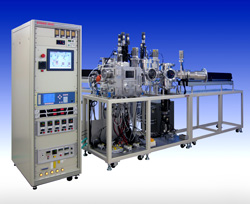 |
|
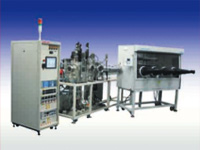 |
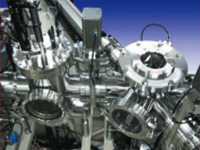 |
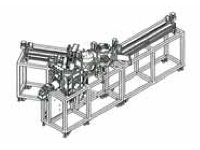 Appearance
|
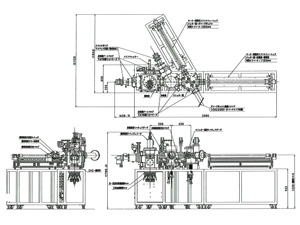 Overall views
|
| Estimate | |
|---|---|
| KVD-OLED Evo.2 | |
* Our company can design and provide the system according to the customers' specifications. For details, click here to contact us.
Line-up of film coating systems for developing organic materials (PDF : Japanese)
http://www.kitano-seiki.co.jp/product/organic/KVD.pdf
- The same room can be used to form films from organic or metal materials.
- Deposition by co-evaporation of organic and metal materials is enabled.
- Deposition by co-evaporation of organic materials is enabled (Max.: 4 elements).
- The system is equipped with a water-cooling jacket for preventing a mixture of organic and metal materials.
- In the deposition room, substrates and masks can be replaced in a vacuum environment.
- The gap between the substrate and the mask is minimized.
- The substrate rotation mechanism achieves an in-plane film thickness distribution of ±5%.
- The organic deposition cell excels in directional characteristics and reduces material contamination in the deposition room.
- A special surface coating is applied over the inner surface of each processing room, which shortens the time to achieve the target vacuum environment pressure.
- The system can be connected to a glove box system.
- PLC control enables automated transfer and exhaustion.
- In the standard state, the load lock room can accommodate a total of five substrates and mask holders.
- A substrate heating room is incorporated for pre-processing.
| System configuration |  |
|
|---|---|---|
| No. of film Deposition rooms | 1: Used for both organic and metal materials | |
| Deposition sources | 8 for organic and 2 for metal materials. | |
| Substrate size (inch) | 2 | |
| Film thickness resolution (Å/s) |
0.0057 Å/s (with CYGNUS made by INFICON) | |
| No. of film thickness sensors | 4: Used for both organic and metal materials | |
| Cooling system for film thickness sensors |
Water-cooling (The chiller controls temperature at an accuracy of 0.01°C.) | |
| Deposition by co-evaporation of organic materials |
Enabled (A unique control method allows a dope mixture ratio of 0.1 to 30wt% when host materials are deposited at 1Å/s.) | |
| In-plane distribution (%) | In a 50mm diameter area, ±3% for organic films, and ±5% for metal films | |
| Preprocessing room | 1 (for heating substrates) | |
| No. of racks in the load lock room |
5 | |
| Ultimate pressure (Pa) |
Deposition room |
10-6 class |
| Load lock room |
10 | |
| Vacuum evacuation system |
Deposition room |
Cryo pump |
| Preprocessing room |
Cryo pump | |
| Load lock room |
Dry pump | |
| Dry pump (roughing vacuum pump) | ||
| Input power source | 3φ 200V 130A | |
| Automated exhaustion |
Enabled (optionally)
 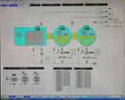 |
|
| Automated vent | ||
| Automated transfer | ||
| Automated vapor deposition | ||
| Substrate heating during vapor deposition |
Enabled (optionally) | |
| Glove box connection | Enabled (optionally) | |
| Space required for installing only the system |
3800×1200 | |
Deposition system for developing organic materials
KVD-OLED Evo.3
- Developing organic EL materials
- Developing high-polymer materials
- Developing phosphorescent materials
- Developing organic thin-film solar cells
- Developing organic electronics devices, etc.
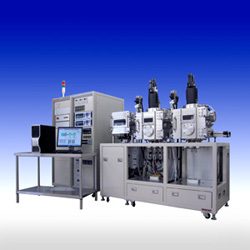 |
|
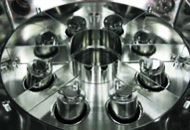 |
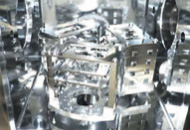 |
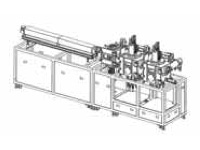 Appearance
|
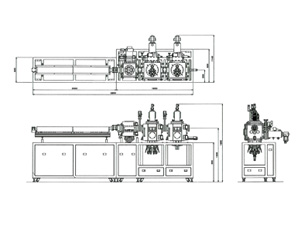 Overall views
|
| Estimate | |
|---|---|
| KVD-OLED Evo.3 | |
* Our company can design and provide the system according to the customers' specifications. For details, click here to contact us.
Line-up of film coating systems for developing organic materials (PDF : Japanese)
http://www.kitano-seiki.co.jp/product/organic/KVD.pdf
- The system is equipped with a water-cooling jacket for preventing a mixture of organic and metal materials.
- In the deposition room, substrates and masks can be replaced in a vacuum environment.
- The gap between the substrate and the mask is minimized.
- The substrate rotation mechanism achieves an in-plane film thickness distribution of ±5%.
- The organic deposition cell excels in directional characteristics and reduces material contamination in the room.
- A special surface coating is applied over the inner surface of each processing room, which shortens the time to achieve the target vacuum environment pressure.
- The system can be connected to a glove box system.
- In the standard state, the load lock room can accommodate a total of twelve substrates and mask holders.
- PLC control enables automated transfer and exhaustion.
| System configuration |  |
|
|---|---|---|
| No. of deposition rooms | 1 for organic materials, and 1 that is used for both organic and metal materials | |
| Deposition sources | 8 + 6 for organic materials and 3 elements for metal materials | |
| Substrate size (inch) | 2 | |
| Film thickness resolution (Å/s) |
0.0057 Å/s (with CYGNUS made by INFICON) | |
| No. of film thickness sensors | 4 sensors for each room | |
| Cooling system for film thickness sensors |
Water-cooling (The chiller controls temperature at an accuracy of 0.01°C.) | |
| Deposition by co-evaporation of organic materials |
Enabled (A unique control method allows a dope mixture ratio of 0.1 to 30wt% when host materials are evaporated at 1Å/s.) | |
| In-plane distribution (%) | In a 50mm diameter area, ±3% for organic films, and ±5% for metal films | |
| Preprocessing room | - | |
| No. of racks in the load lock room |
4X3 (rows) | |
| Ultimate pressure (Pa) |
Deposition room |
10-6 class |
| Load lock room |
10-5 class | |
| Vacuum evacuation system |
Deposition room |
Cryo pump |
| Preprocessing room |
- | |
| Load lock room |
Turbo molecular pump | |
| Dry pump (roughing vacuum pump) | ||
| Input power source | 3φ 200V 150A | |
| Automated exhaustion |
Enabled (optionally)
  |
|
| Automated vent | ||
| Automated transfer | ||
| Automated vapor deposition | ||
| Substrate heating during vapor deposition |
Enabled (optionally) | |
| Connection with a glove box system |
Enabled (optionally) | |
| Space required for installing only the system |
3900X1200 | |
Deposition system for developing organic materials
KVD-OLED Evo. Cluster
- Developing organic EL materials
- Developing high-polymer materials
- Developing phosphorescent materials
- Developing organic thin-film solar cells
- Developing organic electronics devices, etc.
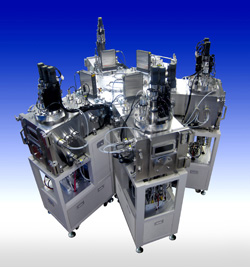 |
|
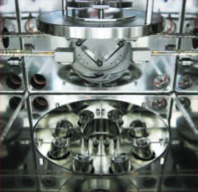 |
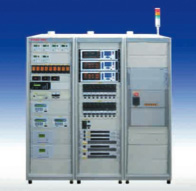 |
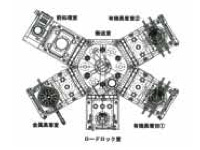 Appearance
|
 Overall views
|
| Estimate | |
|---|---|
| KVD-OLED Evo.Cluster | |
* Our company can design and provide the system according to the customers' specifications. For details, click here to contact us.
Line-up of film coating systems for developing organic materials (PDF : Japanese)
http://www.kitano-seiki.co.jp/product/organic/KVD.pdf
- The 3-axis robot mechanism enables the transfer of masks and specimens.
- The transfer room can optionally be equipped with a substrate holder vacuum sealing mechanism.
- Deposition by co-evaporation of organic materials is enabled (Max.: 4 elements).
- Vapor deposition of eight types of organic materials can be prepared in the same room.
- Two organic deposition rooms are incorporated. This allows 16 organic deposition sources to be installed.
- The system is equipped with a water-cooling jacket for preventing a mixture of organic and metal materials.
- In the deposition room, substrates and masks can be replaced in a vacuum environment.
- The gap between the substrate and the mask is minimized.
- The substrate rotation mechanism achieves an in-plane film thickness distribution of ±5%.
- The organic deposition cell excels in directional characteristics and reduces material contamination in the deposition room.
- A special surface coating is applied over the inner surface of each processing room, which shortens the time to achieve the target vacuum environment pressure.
- The system can be connected to a glove box system.
- Plasma substrate cleaning is enabled in the preprocessing room.
- In the standard state, the load lock room can accommodate a total of six substrates and mask holders.
- PLC control enables automated transfer, exhaustion, and vapor deposition.
| System configuration | 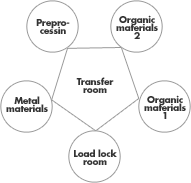 |
|
|---|---|---|
| No. of film deposition rooms | 2 for organic and 1 for metal materials | |
| Deposition sources | 8 X 2 for organic and 5 for metal materials | |
| Substrate size (inch) | 2 | |
| Film thickness resolution (Å/s) |
0.0057Å/s (with CYGNUS made by INFICON) | |
| No. of film thickness sensors | 8 for organic and 2 for metal materials | |
| Cooling system for film thickness sensors |
Water-cooling (The chiller controls temperature at an accuracy of 0.01°C.) | |
| Deposition by co-evaporation of organic materials |
Enabled (A unique control method allows a dope mixture ratio of 0.1 to 30wt% when host materials are Deposited at 1Å/s.) | |
| In-plane distribution (%) | In a 50mm diameter area, ±3% for organic films, and ±5% for metal films | |
| Preprocessing room | 1 (Plasma cleaning) | |
| No. of racks in the load lock room | 12 | |
| Ultimate pressure (Pa) |
Deposition room |
10-6 class |
| Load lock room |
10-5 class | |
| Vacuum evacuation system |
Deposition room |
Cryo pump |
| Preprocessing room |
Turbo molecular pump | |
| Load lock room |
Turbo molecular pump | |
| Dry pump (roughing vacuum pump) | ||
| Input power source | 3φ 200V 200A | |
| Automated exhaustion | Standard feature | |
| Automated vent | Standard feature | |
| Automated transfer | Standard feature | |
| Automated vapor deposition | Standard feature | |
| Substrate heating during vapor deposition |
Enabled (optionally) | |
| Connection with a glove box system |
Enabled (optionally) | |
| Space required for installing only the system |
2000X2000 | |
Deposition system for developing organic materials
KVD-OLED Evo.1
- Developing organic EL materials
- Developing high-polymer materials
- Developing phosphorescent materials
- Developing organic thin-film solar cells
- Developing organic electronics devices, etc.
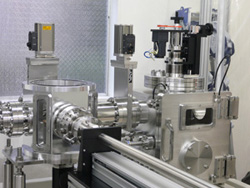 |
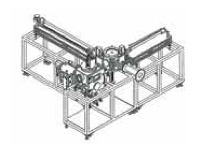 Appearance
|
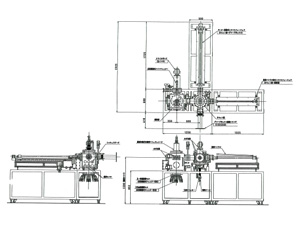 Overall views
|
| Estimate | |
|---|---|
| KVD-OLED Evo.1 | |
* Our company can design and provide the system according to the customers' specifications. For details, click here to contact us.
Line-up of film coating systems for developing organic materials (PDF : Japanese)
http://www.kitano-seiki.co.jp/product/organic/KVD.pdf
- The transfer mechanism allows the transfer of masks and specimens.
- The same room can be used to form films from organic or metal materials.
- Deposition by co-evaporation of organic and metal materials is enabled.
- Deposition by co-evaporation of organic materials is enabled (Max.: 4 elements).
- The system is equipped with a water-cooling jacket for preventing a mixture of organic and metal materials.
- In the deposition room, substrates and masks can be replaced in a vacuum environment.
- The gap between the substrate and the mask is minimized.
- The substrate rotation mechanism achieves an in-plane film thickness distribution of ±5%.
- The organic deposition cell excels in directional characteristics and reduces material contamination in the deposition room.
- A special surface coating is applied over the inner surface of each processing room, which shortens the time to achieve the target vacuum environment pressure.
- The system can be connected to a glove box system.
- PLC control enables automated transfer and exhaustion.
- In the standard state, the load lock room can accommodate a total of five substrates and mask holders.
| System configuration |  |
|
|---|---|---|
| No. of deposition rooms | 1: Used for both organic and metal materials | |
| Depositon sources | 6 for organic materials and 3 for metal materials | |
| Substrate size (inch) | 2 | |
| Film thickness resolution (Å/s) |
0.0057Å/s (with CYGNUS made by INFICON) | |
| No. of incorporated film thickness sensors |
4: Used for both organic and metal materials | |
| Cooling system for film thickness sensors |
Water-cooling (The chiller controls temperature at an accuracy of 0.01°C.) | |
| Deposition by co-evaporation of organic materials |
Enabled (A unique control method allows a dope mixture ratio of 0.1 to 30wt% when host materials are evaporated at 1Å s.) | |
| In-plane distribution (%) | In a 50mm diameter area, ±3% for organic films, and ±5% for metal films | |
| Preprocessing room | - | |
| No. of racks in the load lock room |
5 | |
| Ultimate pressure (Pa) |
Deposition room |
10-6 class |
| Load lock room |
10 | |
| Vacuum evacuation system |
Deposition room |
Cryo pump |
| Preprocessing room |
- | |
| Load lock room |
Dry pump | |
| Dry pump (roughing vacuum pump) | ||
| Input power source | 3φ 200V 75A | |
| Automated exhaustion |
Enabled (optionally)
  |
|
| Automated vent | ||
| Automated transfer | ||
| Automated vapor deposition | ||
| Substrate heating during vapor deposition |
Enabled (optionally) | |
| Connection with a glove box system |
Enabled (optionally) | |
| Space required for installing only the system |
2600X1200 | |







